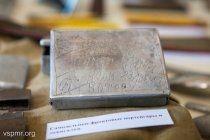 Русский
Русский English
English-







Artifacts from the Great Patriotic War
Just two mistakes in such a familiar word "stew". Instead of the letter "y" here is the Latin "Y". And the Russian "yo" was replaced by "o". However, the strange spelling did not affect the quality of this very stew. According to the recollections of Soviet fighters, these canned goods had quite decent contents. The American stew, which since 1942 the United States supplied to the USSR under Lend-Lease, was jokingly called the second front by Soviet soldiers. Now such a jar with the wrong spelling is one of the exhibits of the Tiraspol United Museum. There is an exhibition dedicated to the day of the liberation of Tiraspol and the Victory Day.
Each exhibit has its own story. There is a handmade cigarette case with a dedicatory inscription “To Commissar Abakumov, 74th separate operational road company”. He was found in Parkany, but how he got there is still a mystery. The owner of the cigarette case, the museum staff found out for sure, died in 1944 in Belarus.
A good half of the artifacts from the times of the Great Patriotic War, before being in the museum under glass, spent decades in the ground. All this is the finds of search engines on the Dniester bridgeheads. As soon as it gets warmer, they go out into the fields, where almost 80 years ago there were battles.
Both Misha Kotov and Kolya Kotov, Vladimir Mayer searched all over the 3rd Ukrainian Front. The fighter Mikhail Kotov was found in the archives of the Russian Ministry of Defense. He only served a little south of the place where the search engines stumbled upon a cigarette case.
Neutralized cartridges under glass at the exhibition are also from the Dniester bridgeheads. Some of them were found in the Kitskany area. Soviet troops were preparing for the liberation for several weeks. Therefore, closer to the villages, search engines often find household items of the Red Army. For example there were spoons. One, more like a small ladle, still a sample of the tsarist army. Other finds include toothbrushes, razors and military belt buckles. They also have their own history.
Another five buckles from the exhibition in the Tiraspol United Museum were remade from German ones. Their search engines also found on the banks of the Dniester. Soviet soldiers rubbed the swastika and literally scratched out the star and used it.










